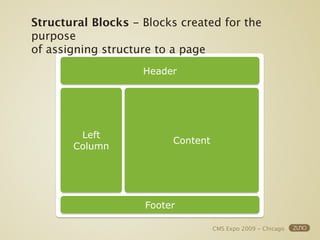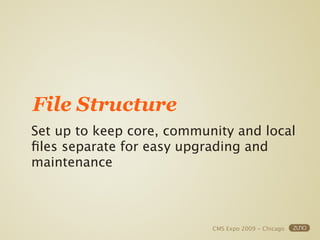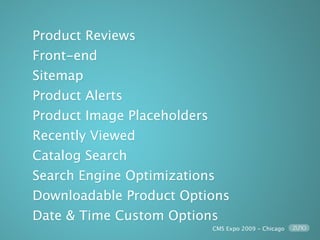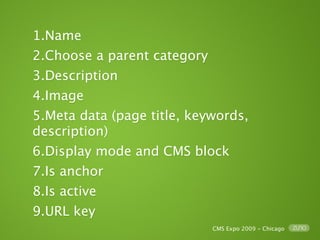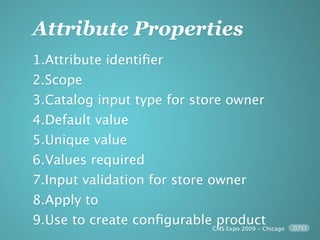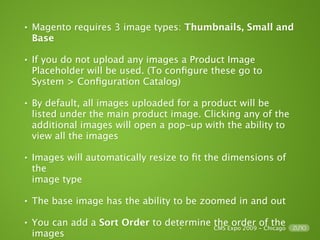Editor's Notes
- #6: one of the most powerful features of Magento is the ability to manage multiple websites and stores from one back-end
- #7: Websites are ‘parents’ of stores.  A website consists of one or more stores. Websites can be set up to share customer data, or not to share any data
- #8: Stores are ‘children’ of websites.  Products and Categories are managed on the store level.  A root category is configured for each store view group, allowing multiple stores under the same website to have totally different catalog structures.
- #9: A store needs one or more store views to be browse-able in the front-end.  The catalog structure per store view will always be the same, it simply allows for multiple presentations of the data in the front.  90% of implementations will likely use store views to allow customers to switch between 2 or more languages.
- #23: customer accounts/profiles
- #28: This determines how your products will be shown in the front-end’s catalog pages. Products per Page - Choose whether the category pages will display 9, 15, or 30 products by default. Your customers will be able to change this, or to display All products. List Mode Grid Only - The products will display in a grid structure and your customers will not have the option to change this. List Only - The products will display in a list structure and your customers will not have the option to change this. Grid (Default)/List - The products will display in a grid structure by default but your customers will be able to switch to list. List (Default)/Grid - The products will display in a list structure by default but your customers will be able to switch to grid. ▪Default Tax Class - Select whether the default tax class for with new products added to your catalog will be Taxable Goods or not. Warning: The “Default Tax Class” feature no longer seems to be available as of 1.1.6. If you know how to re-enable this feature or where the feature has moved, please edit this page and post your solution to the forum (It might be the same feature as System→Configuration→Sales→Tax→Tax Classes). There are two types of product alerts to which you can allow your customers to subscribe via email. Each have their own enable drop-down, and Email Template, but they share the same Email Sender. For more information on how to configure email templates and email sender addresses, refer to Chapter 6: Customers. The Price Alert will create a link in every product page called Sign up for price alert. Clicking this link will subscribe your customer to this alert, and they will receive an email when the product price is changed. This includes adding or changing Special Prices in addition to the regular Price field. The Stock Alert will create a link in every Out of Stock product called Sign up to get notified when this product is back in stock. Clicking this link will subscribe your customer to this alert, and they will receive an email when the product status changes to In Stock. For each product, there is a tab listing all customers subscribed to either of these alerts. There is more information about this in the Products section later in this chapter. This determines the frequency with which Magento checks both product prices and stock status for changes, so that your subscribed customers can be alerted. Frequency - Designate whether you want Magento to check for updates Daily, Weekly, or Monthly. Start Time - Select the time of day (in 24 hour mode) at which you wish Magento to check for updates. Error Email Recipient - Enter the email address to which emails will be sent in case an error occurs during the check for updates. Error Email Sender - Select the address from which the error notification email will be sent. Error Email Template - Select the template which the error notification email will use. This is discussed in more detail later in this chapter, under Products. This is discussed in more detail in Chapter 5: Promotions, Marketing and Content Pages, under Customer Personalization. You can determine the level at which prices are shared in the Catalog Price Scope drop-down. If you select Global, prices will be shared across all websites. If you select Website, prices can differ between websites, although they will still be shared between store views contained in the same website. The price here affects several different areas in Magento. For example, this includes product prices, base currency, price filters in the admin, and catalog/shopping cart price rules. Configure these options to make your site more Search Engine Friendly. Autogenerated site map - If you Enable this feature, a Site Map link will display in the footer on the front-end, directing to an automatically generated site map including a list of all of your existing categories. In addition to the Autogenerated site map, Magento allows for integration with Google Sitemap. There is more information about this below. Popular search terms - If you Enable this feature, a Search Terms link will display in the footer on the front-end, directing to list of all search terms, displayed as a cloud. This is an SEO feature because each of these search terms counts as a link to your site, and is registered by search engines. Page Title Separator - Enter a character in this field, and it will be placed between the various Meta Information in the Page Title, that displays at the top of the browser. Use categories path for product URLs - This determines how the URL Rewrites autogenerate. If you choose Yes, the URL rewrite for products will include the associated category, and a separate rewrite will generate for each associated category. If you choose No, the URL Rewrites will include only the product name, and there will be only one rewrite, regardless of how many categories the product is associated to. Product URL Suffix (cache refresh needed) - This also affects how the URL rewrites autogenerate. The value entered into this field, for example .html, will automatically be added to the end of your URL rewrite generated for products. There is more about this topic in the section about URL Rewrites. If you want to configure Magento integration of Google Sitemap, navigate to System > Configuration and select Google Sitemap from the left column. The sitemap settings for each of these three types of pages can be configured individually. Frequency - Designate how often you would like Google Sitemap to check each type of page for updates. Priority - Designate the priority that each page type receives in relation to the other page types when Google Sitemap updates. ▪Enabled - Select Yes to Enable Google Sitemap autogeneration and automatic updates. Start Time - Select the time of day (in 24 hour mode) at which you wish Google Sitemap to update. Frequency - Designate whether you want Google Sitemap to update Daily, Weekly, or Monthly. This can differ from the frequency that Google Sitemap actually checks for updates (as defined above). Error Email Recipient - Enter the email address to which emails will be sent in case an error occurs during the automatic update. Error Email Sender - Select the address from which the error notification email will be sent. For more information on how to configure these email addresses, refer to Chapter 6: Customers. Error Email Template - Select the template which the error notification email will use. For more information on how to configure these templates, refer to Chapter 6: Customers.
- #42: Attribute Identifier - This is the name of the attribute used by the system. It will appear in the Attributes list in the Attribute Code column, and it will be used when managing Attribute Sets, however it will not appear on the Front-end. Each attribute you create must have a unique Attribute Identifier, and this value cannot contain spaces. Scope - This drop-down determines the level at which the values of this attribute are shared. When creating a product, you will be able to see the Scope to the right of each attribute. You can choose to make any attribute shared Globally, at the Website Level, or at the Store View Level. Global means that the value of this attribute for a given product must be the same throughout your site. Website means that the value of this attribute for a given product can differ in different Websites, however it cannot differ between Store Views contained under the same Website. Store View means the value of this attribute for a given product can differ in all Websites and all Store Views. For example, if you were creating an attribute called Color, with a Store View Scope, you would be able to set the color of a product to green in one Store View, and blue in another Store View. Catalog Input Type for Store Owner - This describes what kind of data the attribute will store. What’s set here determines how data entry for this attribute will take place. For example, a Description attribute would use a text field, so that you can manually enter a description for each product, whereas a Color attribute would use a drop-down, so that you choose the color of each product from a drop-down list (the values of which you will enter in the Manage Label / Options tab). Note that it appears that Attributes whose input type requires multiple predefined optionss, such as the Dropdown or Multiple Select types, cannot later be changed to direct input types like text boxes (and the reverse may also be true), so think hard before making an input type selection. Default Value - If you choose to enter a Default Value, each new product created with this attribute will automatically have this attribute prepopulated with the value you enter here. However, you will always be able to edit the prepopulated value. This field will not display if you have selected Multiple Select, Dropdown, or Media Image as your Input Type. If you have a Dropdown or Multiple Select Input Type, you will be able select the Default Value in the Manage Label / Options tab. Unique Value - If you designate an attribute to be a Unique Value, that means the value selected or entered for this attribute for each product must be different. If Color was a unique value, only one product could be green, one be blue, etc. Values Required - If you require values, you must select a value for this attribute for each product you create. You will not be able to save a product if this attribute is left blank. Input Validation for Store Owner - This controls the type of check Magento places on the values entered for this attribute for each product. If you select None, you can enter any type of information as the value for this attribute. If you select Email, for example, Magento will make sure that the value entered for each product resembles an email address. If it does not, you will receive a warning message. Apply To - Decide which Product Types will include this attribute. The three Product Types in Magento are Simple, Grouped, and Configurable Products (there is more information on the differences between these Product Types in the Products section later in this chapter). If you select Selected Product Types, a multiple select menu will appear where you can choose to which of the Products Types this attribute will be associated. Use To Create Configurable Product - This drop-down will only appear if the Scope is Global and the Input Type is Dropdown. If you select Yes, this attribute will be a Configurable Attribute. When creating a Configurable Product, the next step after selecting the Attribute Set and Product Type is to select the Configurable Attributes for this product. You will see a list of all the existing Configurable Attributes associated to the Attribute Set. If you select the checkbox, this attribute will be a Configurable Attribute for this product. If you leave the checkbox empty, this attribute (while still a Configurable Attribute in your attribute settings) will not be a Configurable Attribute for this product. If an attribute is a Configurable Attribute, this means that the customer will be able to select the value of the attribute from a drop-down in the front-end. It is customer configurable. For more information about Configurable Products, please refer to the Products section later in this chapter. Note: This drop-down is not related to the Apply To menu above. An attribute can be a Configurable Attribute even if it is not applied to Configurable Products. If this is the case, you will be able to select the attribute as a Configurable Product when creating a product, but you will not be able to see this attribute among the product’s other attributes in the New Product page.
- #43: Use in quick search - If you select Yes, Magento will search all the product values for this attribute when your customer uses the search bar in the header. If you select to use Color in the quick search, your customers will be able to type in green or blue and find products that match that color. For more details, see Chapter 5: Promotions, Marketing and Content Pages. Use in advanced search - This is very similar to the quick search. However, in the Advanced Search, each attribute will have its own field, rather than there being one search field. If you select Yes, a field will be created for this attribute in the Advanced Search page. For more details, see Chapter 5. Comparable on Front-end - If you select Yes, a row will be created for this attribute in the Compare Products pop-up window. For more details, see Chapter 5. Use in Layered Navigation - Magento’s Layered Navigation allows your customers to filter down into a category’s products using any attribute that is “filterable” for Layered Navigation. The Layered Navigation menu will display in the left column of your category pages, and will contain all of the attributes which are filterable. Under each attribute will display the various values of that attribute. Clicking one of these values will filter the list of products in that category page so that only products matching that attribute value will display. There are two types of filterable attributes, which you can select from this drop-down: Filterable (with results) and Filterable (no results). This determines which values will display in the Layered Navigation menu. If you select Filterable (with results), only values that correspond to products in that category page will display in the menu (that is, only values that produce “results” when used as a filter). If you select Filterable (no results), all values that you’ve created in the Manage Label / Options tab will list, whether or not they correspond to any particular products in that category page (it includes values that do not produce “results” when used as a filter). If there are no filterable attributes in a particular category page, the Layered Navigation menu will not display. In order to make an attribute filterable, the Input Type must be either Dropdown, Multiple Select, or Price. Position - This determines the position of the attribute in the Layered Navigation menu with respect to the other filterable attributes. Visible on Catalog Pages on Front-end - This field only appears for Simple Attributes. On the product page in the front-end, there is a section called Additional Information, that displays below the Product Description section. The attribute name and value for all “visible” Simple Attributes will display in this section. If a product does not have any visible Simple Attributes (or if the product does not have any values selected for its Simple Attributes) there will be no Additional Information section on the front-end.
- #44: Manage Titles - In the Admin field, you must enter the name of the attribute as it will appear in the admin. For each Store View, you can specify a different name for this attribute. This is useful if you manage multiple Store Views with different languages. For example, in the Admin field, type Color; in the UK Store View field, type Colour; in the French Store View field, type Couleur. If you leave the field blank for any of the Store Views, the Admin Label will be used. Manage Options - This section will only appear if the Input Type is Dropdown or Multiple Select. In order to have a drop-down or multiple select menu in the product page, you must have predetermined values to populate these menus. This is where the values for these menus are predetermined. This works very similar to the Manage Titles section above. For each value you wish to create, click Add Option. You can enter an unlimited number of values. For each value, you must enter a name in the Admin field, and you have the option to enter a different name for each Store view. For example, create two options. For the first option, enter Green in the Admin field; leave the UK Store View field blank, because it uses the same name; enter Vert in the French Store View field. For the second option, enter Blue in the Admin field; leave the UK Store View field blank; enter Bleu in the French Store View field. You will also have the option to select the position and which value(s) is the default. Enter a numerical value in the Position field, and this will determine the sort order of the values in the drop-down/multiple select menu relative to each other. For the Dropdown Input Type, you will have an Is Default radio button with which you can select one value. For the Multiple Select Input Type, you will have an Is Default checkbox with which you can select multiple values.
- #49: Note: Once the Attribute Set has been selected, it cannot be changed. You can change the attributes in a product by creating a new product and assigning a different Attribute Set. You can also edit the Attribute Set, and add or remove attributes, however this will affect all products associated to this Attribute Set.
- #100: You’ll notice how Magento ignores the version of the redundant file lower in hierarchy and recognizes only the version higher in hierarchy. This is because it’s already found the required file and need not search for it any longer, ergo terminating the search for that specific file while continuing the search for other required files yet to be found.



















